Ditch the artificial colors and flavorings of packaged Jell-O by making your own healthy gelatin dessert using fresh fruits and fruit juices.
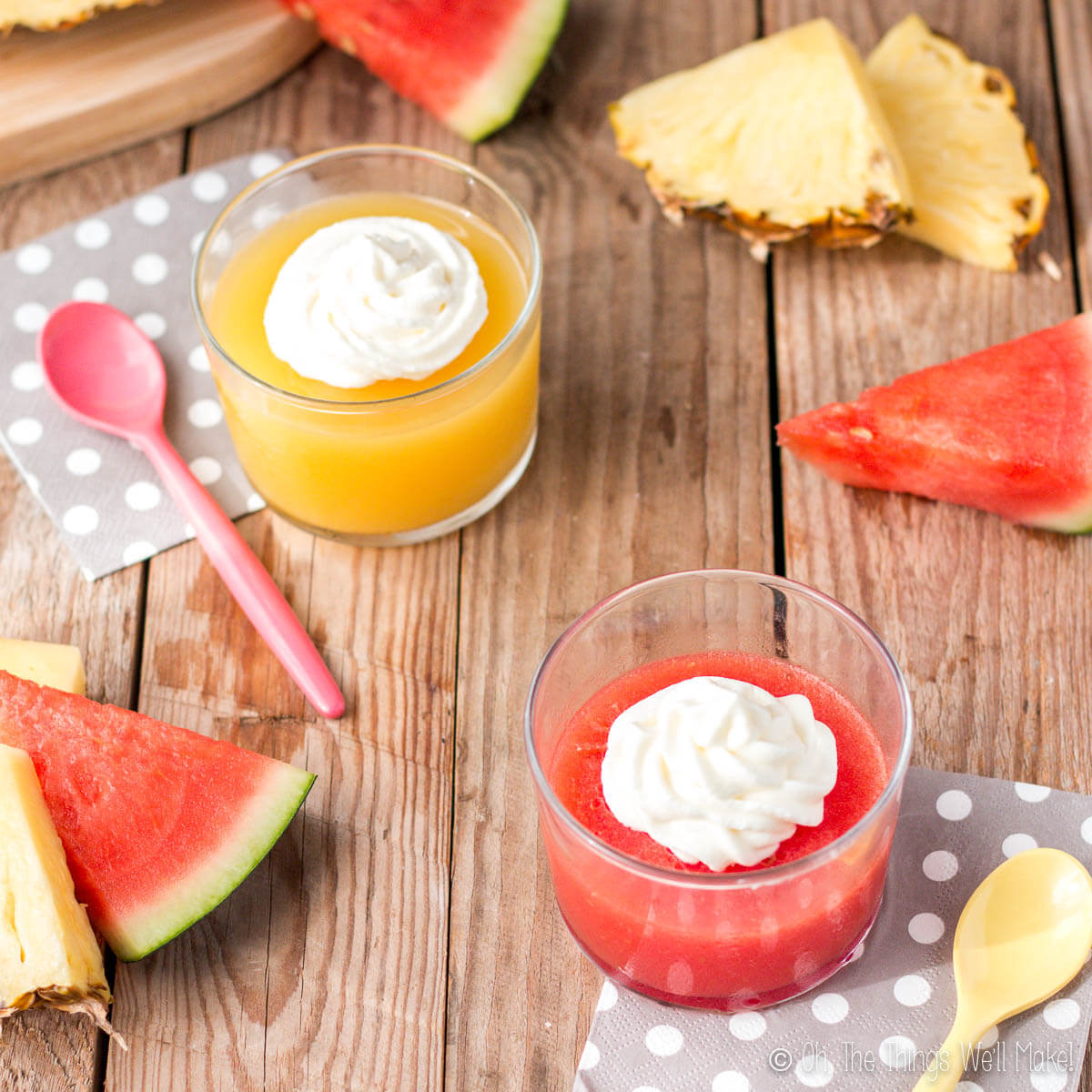
Here in Spain, packaged gelatin mixes aren’t very popular. We don’t have the Jell-O brand and the only available mixes generally only come in one or two colors or flavors. They do sell some pre-made gelatin desserts in the refrigerated section of the supermarket, though.
After seeing my son eat a bright red gelatin dessert at my mother-in-law’s house, I decided to try to make him a more natural alternative.
Why make it?
The great thing about making a gelatin dessert at home is that you can control the ingredients. You can reduce the amount of sugar or use whatever sweetener you prefer. Plus, you have a whole new world of flavors available to you sans the artificial colors and ingredients!
Ingredients
Making a gelatin dessert is super simple and you only need two ingredients: fruit and gelatin. While you can use fresh fruit and purée it yourself, you can also use store-bought fruit juice.
For the gelatin, you can use powdered gelatin or gelatin sheets. One tablespoon of powdered gelatin is normally the equivalent of a package of unflavored gelatin or four gelatin sheets. You can use whatever gelatin you like, but I suggest trying grass-fed pastured beef gelatin if you can find it as the healthiest choice.
Many fruits are sweet enough to make a sweet, delicious dessert without needing to add any sort of sweetener. Some fruits, especially those lower in sugar and on the more tart side, might benefit from the addition of sweetness. You can either add a sugar syrup, some honey or maple syrup, or use a low-carb sweetener like stevia.
It’s fun trying out all sorts of different fruits to see how they’ll turn out. By now, my favorite two are probably watermelon and pineapple. While I use fresh watermelon for my gelatin, I normally chose store-bought pineapple juice vs. fresh pineapple.
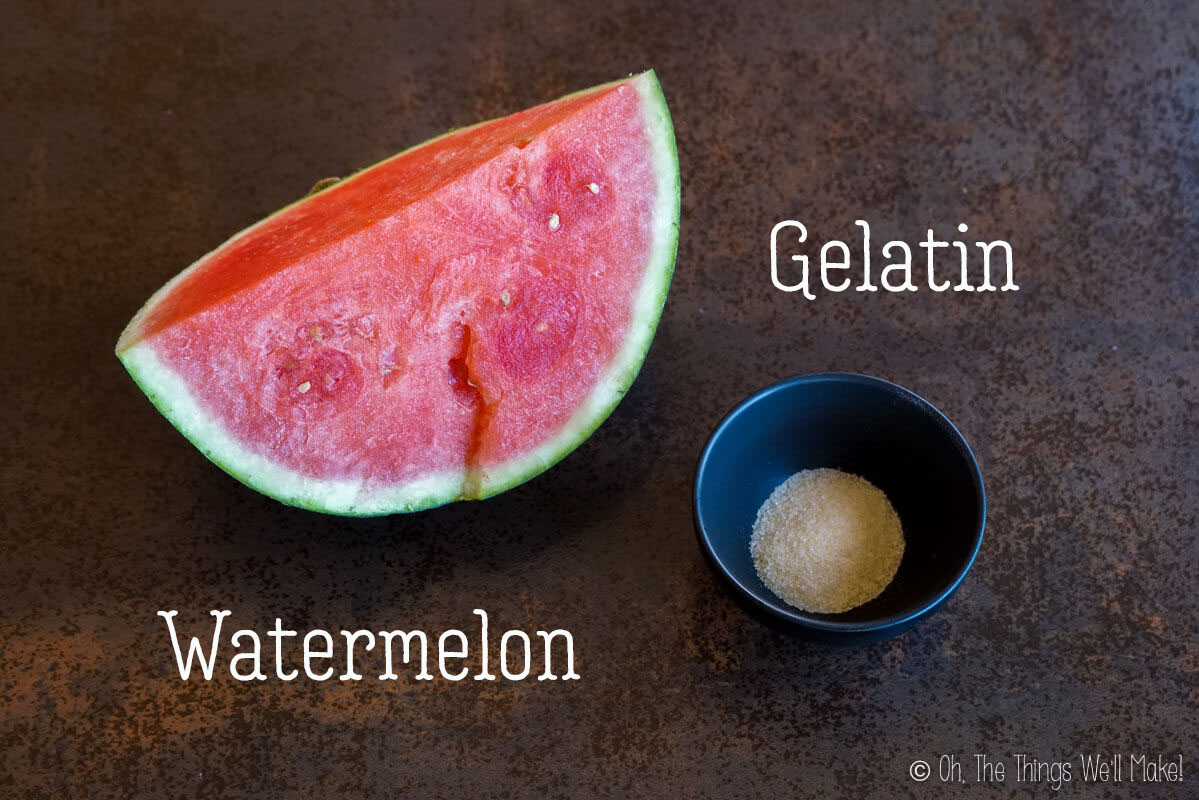
When making watermelon gelatin, I normally use around a quarter of a small watermelon for each tablespoon of gelatin. That amount of fruit generally makes around 2 cups of watermelon juice.
Vegan “gelatin”
You can also use a type of seaweed called agar (or agar-agar) for those avoiding traditional gelatin. “Gelatin” desserts made with agar will be firmer and less “creamy” than those made with gelatin. If choosing agar powder instead of gelatin powder, use around half of a tablespoon of agar powder for every 2 cups of juice. (You can slowly adjust up as needed, but too much makes a rubbery dessert.)
If using agar, you’ll need to boil the mixture briefly to activate it. Once activated, the agar mixture will gel even at room temperature. If yours isn’t gelling, you may need to return the mixture to the saucepan and cook it a bit longer to ensure it is ready to gel.
Juices vs. natural fruit
While I normally love using fresh fruits when possible, in the case of making gelatin, there is good reason to choose fruit juice sometimes. Certain fresh fruit purees, like pineapple, won’t allow the gelatin to set.
Some fruits have proteolytic enzymes that, when used fresh, will keep the gelatin from gelling. The proteases in these fruits break down the protein bonds of the gelatin, keeping it from setting. A long time ago, I found out the hard way when I tried to make myself pineapple gelatin from the fruit I had at home.
You may recognize some of these fruits as being natural meat tenderizers for the very same reason. Just think, pineapple is so good at breaking down proteins that even your mouth can feel a bit tender after eating it!
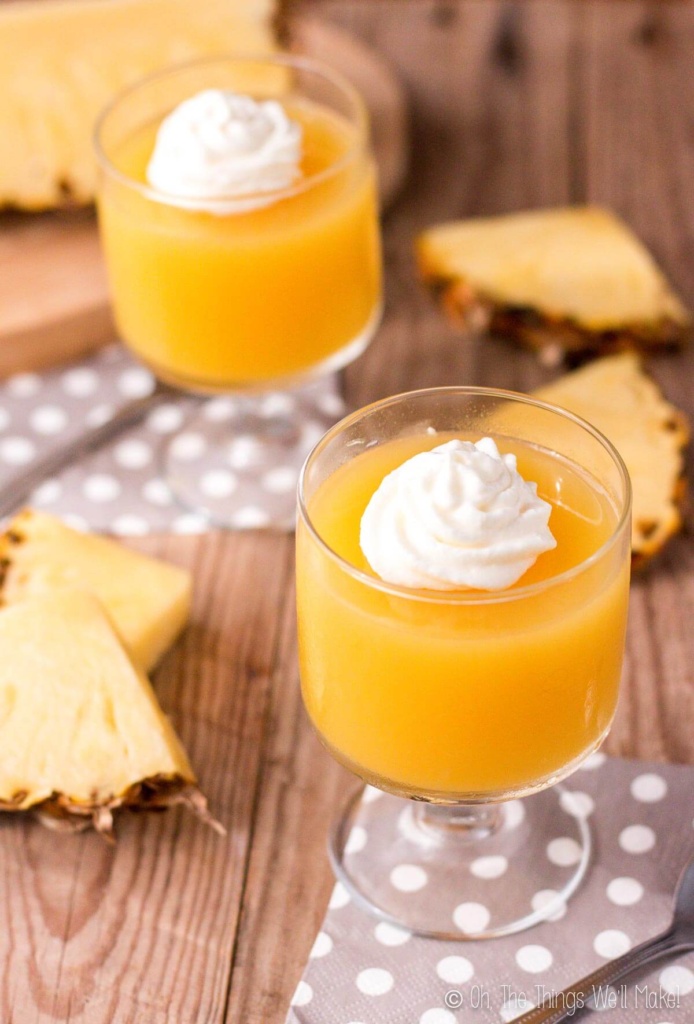
Pineapple gelatin is one of my favorites. 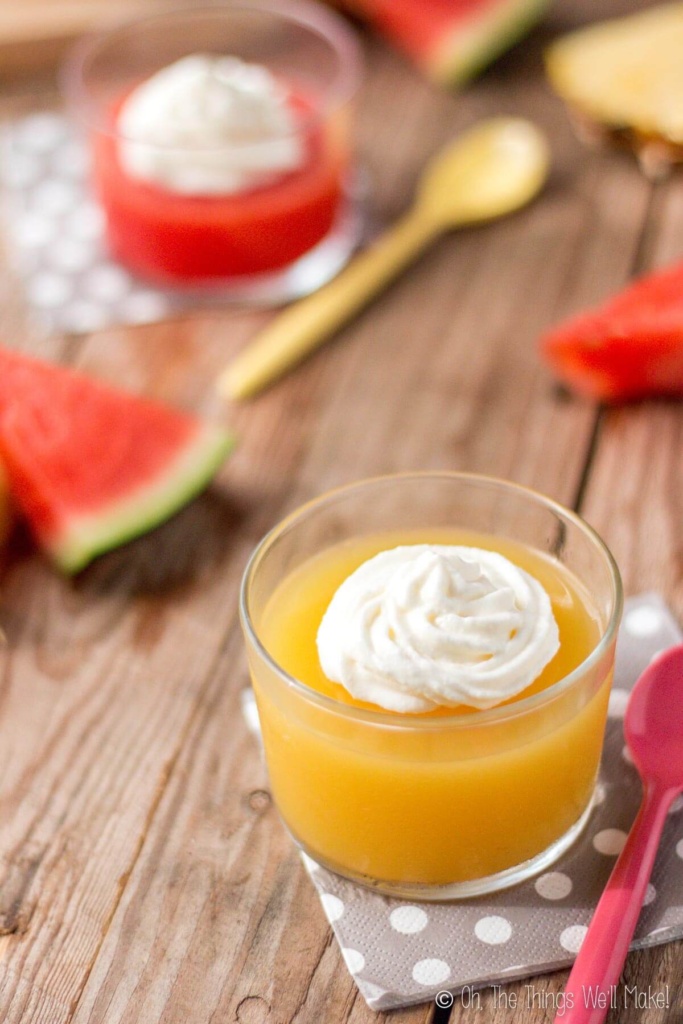

I also love watermelon gelatin.
Fresh Fruits to Avoid (They won’t set!)
If wanting to make gelatin with any of the following fruits, you’ll either need to cook them long enough to break down the enzymes or you’ll need to use pasteurized juices.
- Pineapple
- kiwi
- mango
- figs
- papaya
- ginger
- guava
- pawpaw
Why do store bought fruit juices work?
If you puree or juice one of the above fruits while fresh or frozen, the proteases in those fruits remain intact. They break down the bonds in the gelatin, keeping it from setting.
On the other hand, almost all store-bought fruit juices are pasteurized. The pasteurization process kills off the enzymes that keep the gelatin from gelling. While that’s great for making a gelatin dessert, keep that in mind the next time you buy a store-bought fruit juice thinking it’s the same as a juice that you’d make at home from fresh fruit!
While organic, pure fruit juices are definitely better than other store-bought options, I normally save fruit juices for desserts and occasional treats. To get the healthiest fruit juice available, look for one that isn’t sweetened and one that isn’t from concentrate.
Making gelatin from fresh fruit
When using fresh fruit, first, make the fruit juice or purée. Depending on the fruit used, you’ll need to remove skins and seeds first. Use a juicer or place small fruits, or small pieces of larger fruits, into a blender and blend until smooth. I normally keep all of the fiber and the tiny seeds of fruits such as berries, but you can also choose to strain the juice for clearer gelatin.
Also depending on the fruit chosen, you may want to add some water (or something like coconut water) to thin out the juice. I don’t add any water when using fruits with a lot of water content like watermelon. I do usually add some to purées made with berries as they can be quite thick.
You can also soften the gelatin in water rather than soften the gelatin directly in part of the juice. Either way, it’s a good idea to soften the gelatin before cooking it in some of the juice. When mixing the gelatin with the cold water or juice and allowing it to rest, it will expand and soften. This is called blooming the gelatin.
I usually use around 2-3 tablespoons of water or juice for every tablespoon of gelatin for blooming the gelatin. For this recipe, I use around 2 cups of liquid total. This can be only fruit purée or a mixture of fruit and water.
Pour around a half cup of fruit purée into a saucepan and heat it on low to medium heat. It doesn’t need to boil but should be hot enough to dissolve the softened gelatin. Add the softened gelatin to the saucepan with the fruit puree and stir until the gelatin is dissolved.
Once the gelatin has dissolved, remove the saucepan from the heat. Then, add the rest of the fruit puree, stirring it until it is well incorporated into the gelatin mixture. Taste the mixture for sweetness and add a sweetener of choice if you feel it needs it.
Once you are happy with the flavor, pour the mixture into serving dishes. Place them in the fridge until the gelatin is fully set.
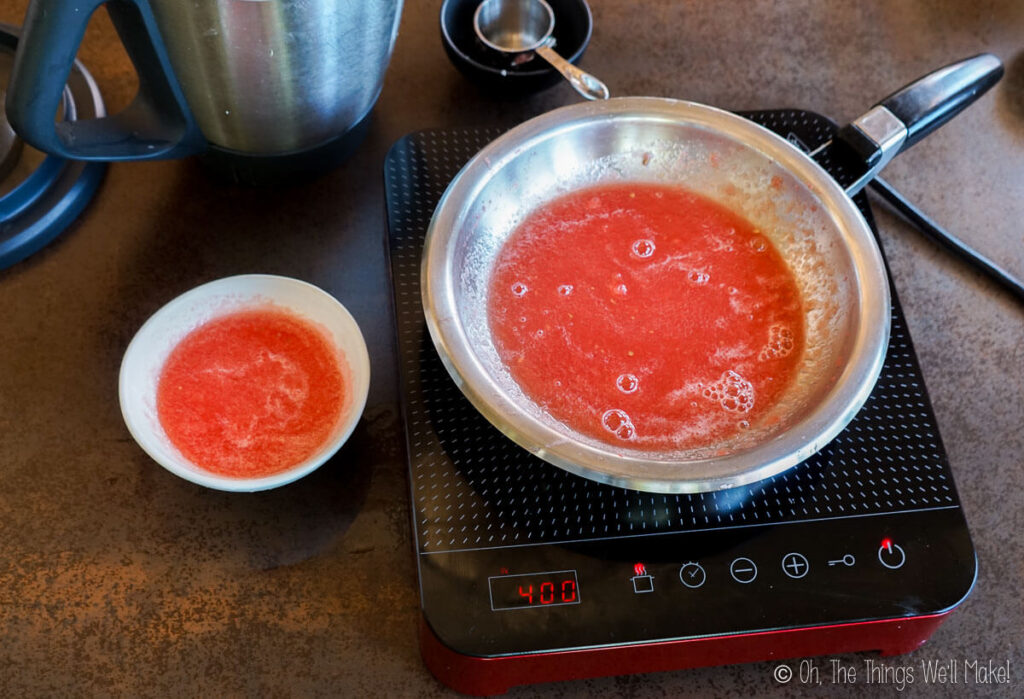
Soften the gelatin while you heat part of the purée. 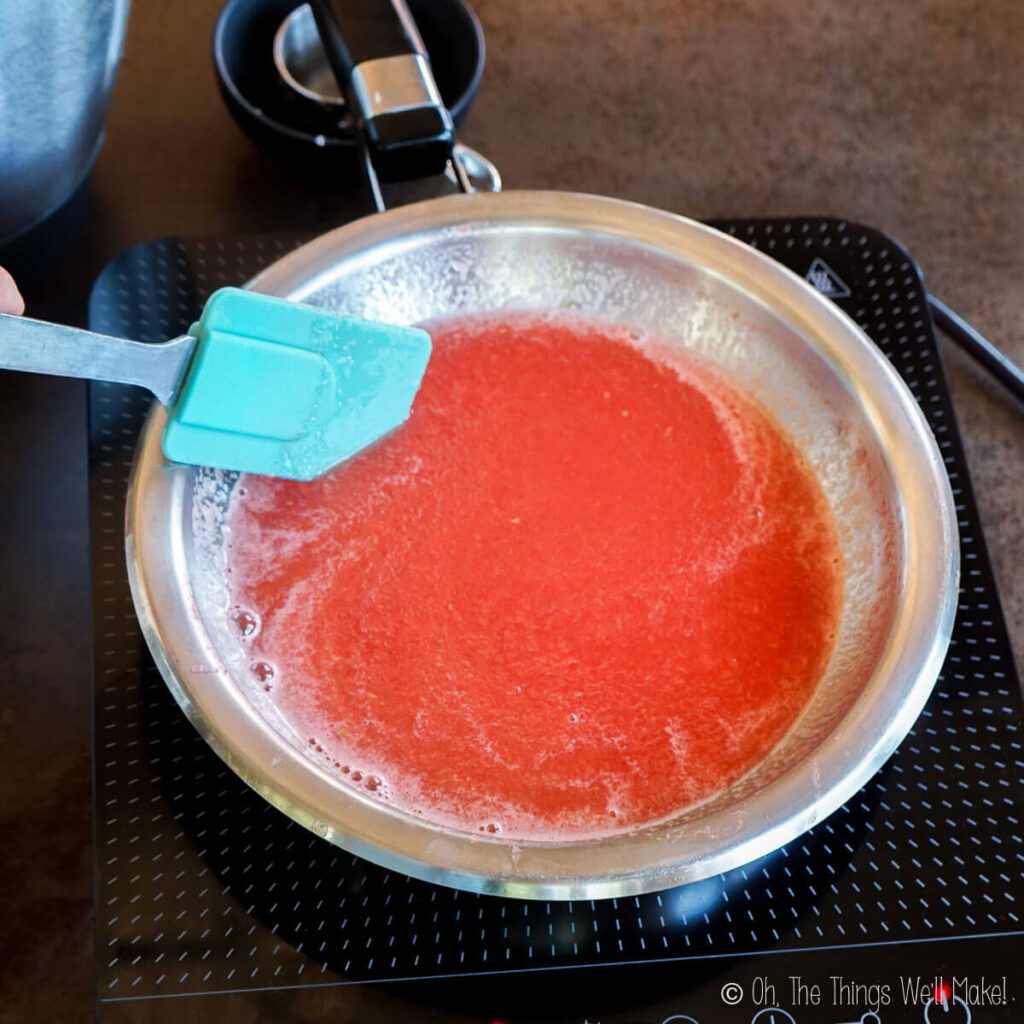
Cook the gelatin with part of the purée. 
Add the rest of the cool purée. 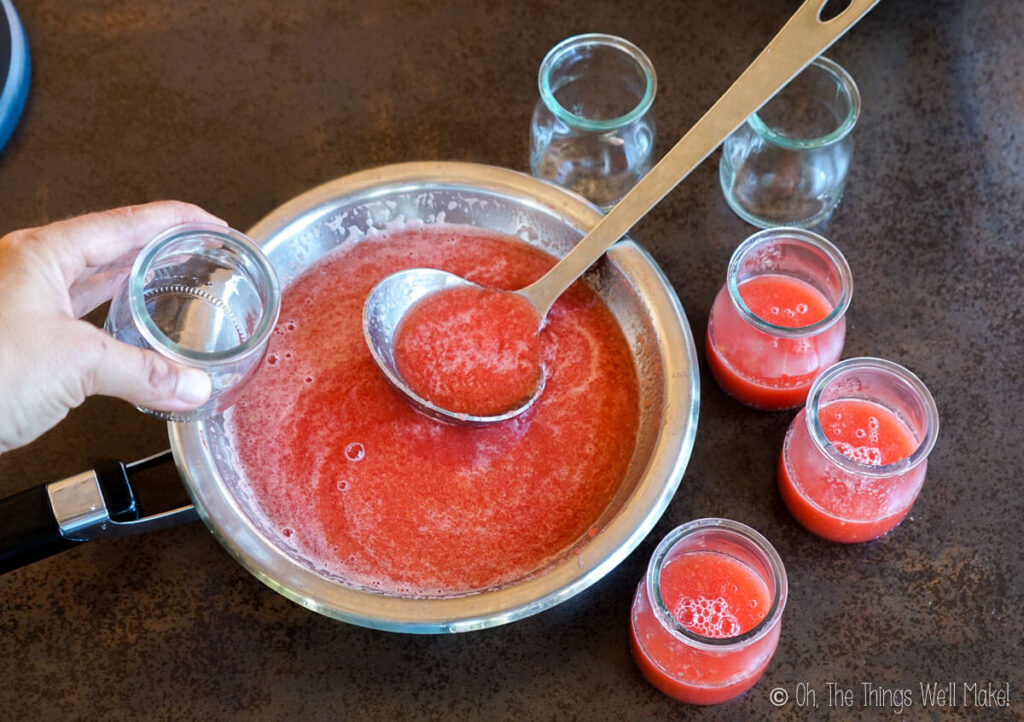
Pour into serving dishes.
Making gelatin from juice
If using juice instead of fresh fruit, the process is even easier!
First, soften the gelatin in around one-fourth of a cup of juice.
Next, heat around 3 quarters of a cup of the juice over medium heat in a saucepan. It doesn’t need to come to a boil but should be warm enough to dissolve the gelatin.
Add the softened gelatin to the saucepan with the juice, and mix until the gelatin has completely dissolved.
Once it has dissolved, remove the mixture from the heat source and add the remaining cool juice. Stir them together thoroughly. Taste the mixture for sweetness and add honey or another sweetener if you feel it needs it. (This will depend a lot on the fruit used.)
Pour the mixture into serving dishes, refrigerate until the gelatin sets.
Adjusting the recipe
Apart from adjusting the recipe for sweetness by taste, you can also adjust the consistency of the gelatin.
The ratio of one tablespoon of gelatin to 2 cups of liquid normally makes gelatin with a consistency similar to that of Jell-O. (The consistency may vary somewhat depending on the juice or purée used.) If you want thicker gelatin that you can cut into squares (like “finger Jell-O”), increase the amount of unflavored gelatin.
If you find the mixture too sweet, or just want a change, adding a dash of lemon or lime juice can also add a new dimension to the flavor.
Gelatin popsicles
A fun way to serve homemade gelatin is to freeze it in popsicle molds to make gelatin popsicles. They’re a delicious treat in the summer. Not only is their texture a bit “creamier” than icy pops made with only fruit juice, but they are also less messy. Because of the set gelatin, these popsicles don’t drip is they melt! That makes them great for kids.
For some fun serving ideas, see my post dedicated to making gelatin popsicles.
Video
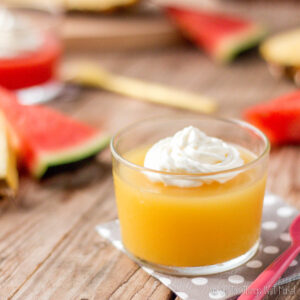
Healthier Gelatin Dessert
Ingredients
Instructions
Making gelatin from a fruit puree
- When using a fruit purée to make gelatin, begin by softening the gelatin in a little bit of water. (If you are using a thin puree like watermelon, you can soften the gelatin in a little bit of the cold purée instead.) Use around 3 tablespoons of water for every tablespoon of gelatin.
- Make the fruit purée by placing the small fruits, or small pieces of larger fruits, into a blender container and blending until smooth. Fruits with lots of water like watermelon will make a thin, juice-like puree that is perfect for making a smooth gelatin. Other fruits, like berries, will make a thicker puree that you can water down (with some water, coconut water, or juice) for a smoother gelatin. You can also strain out the small seeds of fruits like berries. Purée enough fruit to end up with around 2 cups of puree mixture (including added liquid, if used).
- Pour around 1 cup of the fruit purée into a saucepan. Cook it on low to medium heat.
- Add the softened gelatin to the saucepan with the fruit puree and stir, over the heat, until the gelatin has dissolved.
- Remove the saucepan from the heat, and pour in the rest of the fruit puree, stirring it until the cool purée is well incorporated into the warm gelatin mixture.
- Taste the mixture for sweetness. Add some honey or maple syrup (or another sweetener)if you feel the mixture needs sweetening.
- Pour the mixture into serving dishes and refrigerate until the gelatin is fully set.
Making gelatin from juice
- Soften the gelatin in around ¼ cup of the juice.
- Heat around ¾ cup of the juice over low to medium heat in a saucepan.
- Add the softened gelatin to the saucepan with the juice, and mix together well until the gelatin is completely dissolved.
- Remove from the heat source and add in the remaining juice, stirring until well incorporated. You can also add honey or maple syrup to sweeten it more, as needed.
- Pour the mixture into serving dishes, and put into the refrigerator until the gelatin sets.
Notes
This post was originally published on September 1, 2016. It was rewritten, adding new photos and video in July of 2021.
 Español
Español
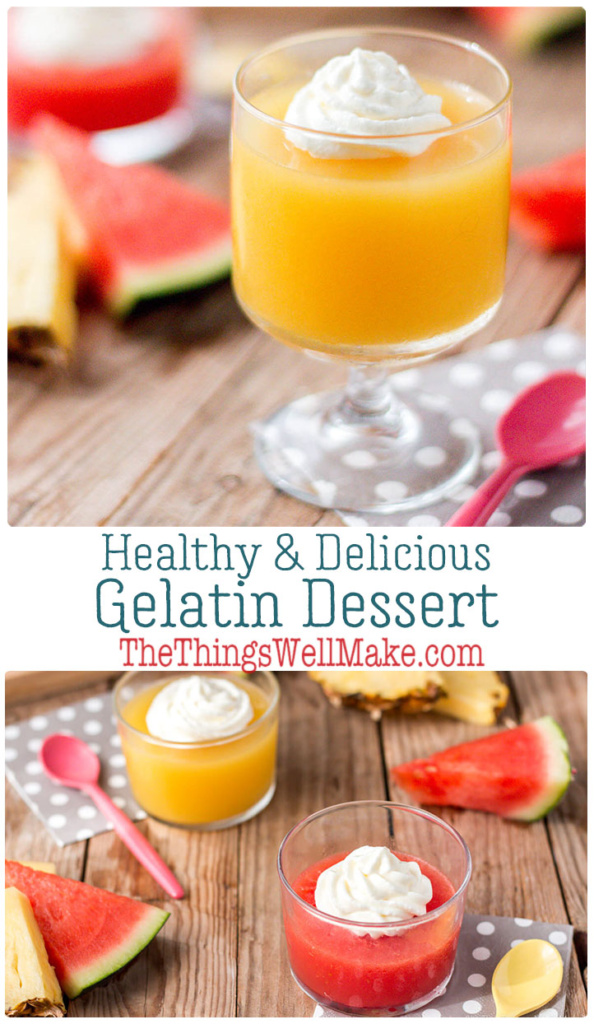
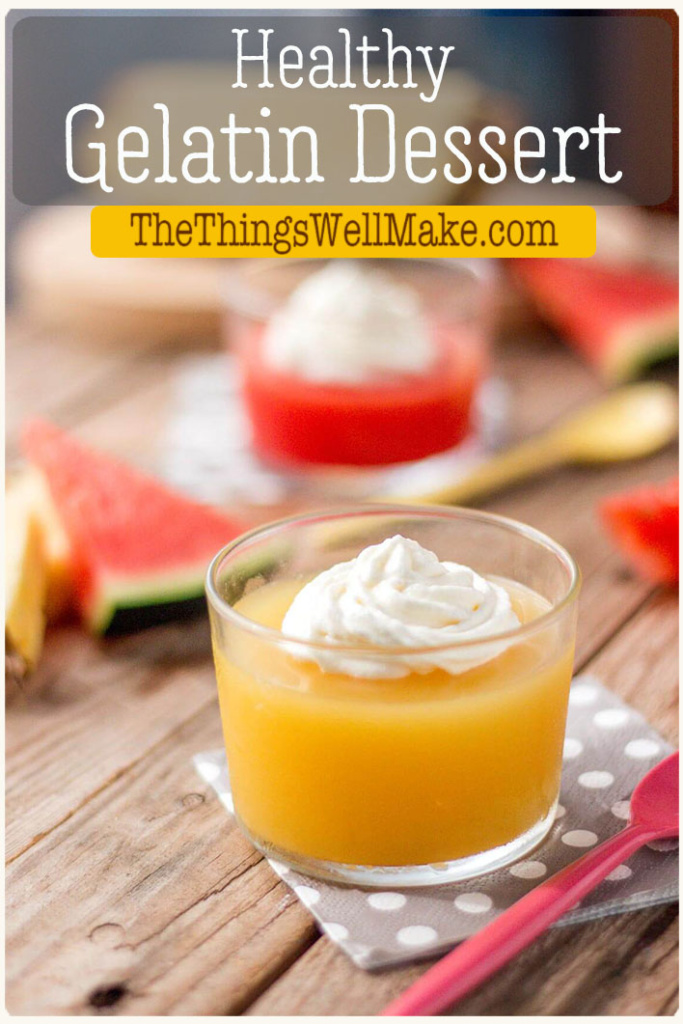
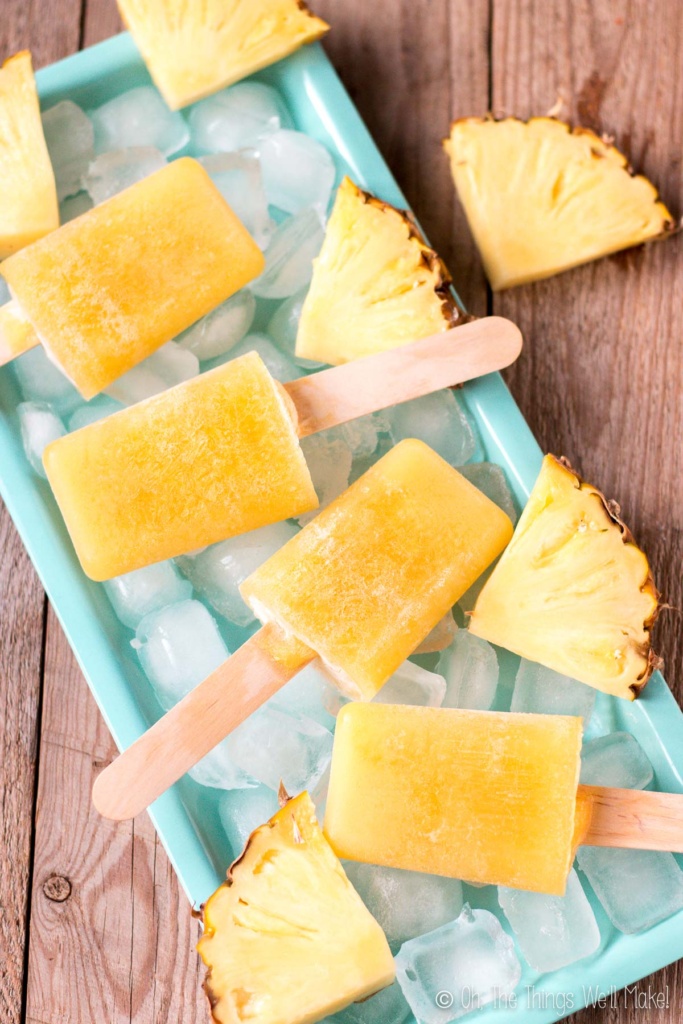
 Watermelon Gelatin Popsicles (Healthy Jello Pops)
Watermelon Gelatin Popsicles (Healthy Jello Pops)
Nel
Thank you! This is exactly what I was looking for.
Tracy Ariza, DDS
You’re welcome, Nel!
Susan
Can you put the mixture in a plastic lined sheet pan. Can you add junks of fruit before it sets.
Thank you
Tracy Ariza, DDS
Yes, both should be fine…
If you use the fruits with the enzymes, though (like fresh pineapple), it may affect the gelling around the fruit.
Monica
This is exactly what I was looking for. Thanks so much!
Tracy Ariza, DDS
You’re very welcome, Monica!
I hope you enjoy it.
Tina DelGiodice
Can I use agar agar instead of gelatin in these recipes? Do you know the proportions? Would be grateful for your help. Thank you, T.
Tracy Ariza, DDS
Hi Tina,
From what I understand, you can sub it with the same amount of agar powder. It’s also important to boil it so that it will set.
Agar will give a different consistency.
Rose
What a disappointing article! I was so interested to learn how to make gelatine from fruit… but after wasting my time reading the enrire page all I learned was to go BUY the gelatine, MELT it, and USE it in a dessert! Not one word about how to “MAKE the gelatine” to start with.
You wouldn’t say “buy a cake” and add some cream was “how to make” a cake, or “buy some chicken soup” and add a vegetable was “how to make” soup, so why say “buy some gelatine” and add fruit as “how to make” gelatine !!!
What a completely ridiculous, time-wasting, let-down. Your WORST atricle ever 🙁 Please don’t do a “how to make banana custard” article that says “buy a tin of custard” and add a banana … duh!
Tracy Ariza, DDS
Gelatin is made from boiling bones and skin and then refining the resulting liquid. I doubt you could refine it enough at home so that you could use it similarly in a sweet dessert.
That said, this was not titled “How to make gelatin from scratch.” It was how to make a gelatin dessert (like Jell-o). I’m sorry it disappointed you that I didn’t go out and butcher a pig and then show the process of how to skin it and boil it to obtain gelatin in the process. I do like to make things from scratch, but sometimes it is a lot more practical to buy certain ingredients that would be nearly impossible to make at home.
Reader
You’re so rude- read the title. She never said “learn how to make gelatin from scratch. DUH
Michelle
Rose,
I believe you are looking for something you will never find. Gelitan can’t be made at home. Shouldn’t be anyway. I am sure there are articles to find if you search”how is gelitan made” beware it is a very unpleasant process. Have you ever noticed that unflavored gelitan smells like a barn when warm water is added to it?
Rebecca
I admire all you have done and are doing 🙂
Tracy Ariza
Thank you, Rebecca! ?